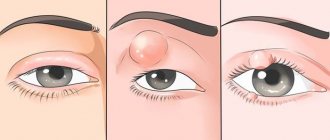Can I wear a contact lens on one eye?
In the life of every “lens wearer,” there have been emergency situations when you had to walk around with one lens , because the second one was lost, torn, etc. Often the feeling is not pleasant (that’s certainly true for me), but some people say that even without a second device they feel quite comfortable. Therefore, I had to ask myself: is it possible to walk with one lens ?
Isn't this dangerous? Let's find out.
“And everyone goes in pairs...”
If we consider that human eyes, as well as arms, legs, ears, kidneys, lungs, and so on, are paired organs, then contact devices, of course, should only be worn in pairs. Agree, hardly anyone would think of painting only one eye or walking around in one sock. Everyone understands this and everyone agrees with it, but it happens that you have to decide: to wear the device without a pair or to stop wearing it altogether for a while.
Wearing a lens on one eye is a very dubious pleasure
When the question arises whether it is possible to wear a contact lens on one eye, we are not talking about the fact that the first eye is healthy, and the second one needs correction. We are talking about emergency situations - such as, for example, the loss of a device and the lack of a spare pair. You can put on one lens, but you can forget about picture clarity and comfortable wearing for a while . And such “monocular” wearing should not last more than two days. The fact is that in such conditions the human brain has to redirect double the load to the eye without a device so that it also receives a clear picture. This often leads to fatigue, pain, and occasionally squinting, and may also cause a headache.
Note! If, due to infection or inflammatory processes, you have to discard the second lens, then it is better to discard the entire pair. This will protect your other eye.
It is better to give up wearing the whole pair than to wear just one device.
Pros and cons of contact lenses for eyes
To improve vision, they must be selected with special care.
Attention! To select the correct CL, consult an ophthalmologist. The doctor will give you the necessary recommendations that you cannot find out on your own.
Pros of use:
Good for correcting vision for nearsighted people. With different diopters on the right and left eyes, they will not allow you to experience discomfort from this discrepancy, unlike glasses. Possibility to correct some difficult cases of astigmatism. Does not narrow the field of view. There is no need to look up at your glasses frame. Comfortable to wear in any weather - they do not fog up, and rain drops do not flow down them. Convenience during sports and tourism, as well as other active activities
Unlike glasses, they do not create glare, which is important for drivers. There is no need to use one pair for “distance” and another for “near”, like with glasses
Multifocal contact lenses can handle this. They will not break and get into your eyes, causing injury. Attractiveness is the ability to give up glasses that don’t work and change your appearance by, for example, wearing lenses of a different color.
Disadvantages of use:
This is a foreign object in the body that must be monitored with special attention. Do not use during illness (for example, flu or acute respiratory viral infection)
Subtleties in selection and care. Should be replaced promptly. Their price is estimated higher than the cost of glasses, which are bought once every few years. You should also definitely purchase disinfectants and accessories - liquid and storage containers. It is imperative to see a doctor, even for those who have been using it for a long time (you should see a specialist at least once every six months).
The harm and benefits of colored eye lenses
Tinted, cosmetic or decorative CLs have the following benefits on the body:
- They not only correct the shade or color of the eye, but also visually remove defects (sores, partial absence of the iris, etc.).
- They can replace sunglasses, becoming a successful alternative.
- Reduce the load on the visual organs with amblyopia (lazy eye syndrome).
- If there are diopters, vision is corrected.
Photo 1. Adria Glamorous colored contact lenses for 3-6 months, South Korea.
In some cases, colored lenses can harm the body, for example:
- If worn and stored incorrectly, the use of these optical items will lead to inflammation of the cornea of the eye, which subsequently threatens blindness.
- If you use cheap, low-quality cosmetics every day, irritation will occur in the eye area from the lenses. You should buy cosmetics thoughtfully or discard them while wearing CL.
- If you choose on your own, you may not guess correctly, and sellers are not always competent in this area. Therefore, the choice of lenses, including colored ones without diopters, should be coordinated with an ophthalmologist.
- When purchasing online, a person is also not immune from receiving low-quality products that will harm eye health.
- If CLs are worn too long, they begin to allow bacteria to enter the eyes, which negatively affects the functioning of the visual organs.
- If you smoke or have various diseases, including influenza and ARVI, wearing contact lenses is not recommended.
For or against the use of night CLs
Night lenses are a type of CL, the principle of which is to correct vision during sleep.
Reference! Also known as “orthokeratology lenses” (OK lenses) from the name of the medical method of vision correction - orthokeratology.
The advantages of using OK lenses are that they allow you to correct vision when:
- Myopia (diopters no higher than -6).
- Myopia that progresses.
- Astigmatism (about 1.5 diopters).
- Inability to correct vision through surgery (for example, in children under 18 years of age).
- The use of glasses and classic contact lenses is prohibited.
With proper adherence to the doctor’s instructions and recommendations, as well as long-term use, such lenses can restore vision down to one.
If vision is slightly impaired, it can be restored.
It is not the OK lenses themselves that cause harm to the patient’s eyes, but non-compliance with the rules of wearing (no more than 8 hours) and storage. Thus, their effects can be harmful and even dangerous; various complications appear - inflammation of the cornea, erosion and conjunctivitis.
For diseases such as keratoconjunctivitis, astigmatism (beyond 1.75 diopters), inflammation of the eyelids, various diseases of the cornea, etc., the use of OK lenses is contraindicated.
A lens on one eye - is it dangerous?
I am, of course, not an ophthalmologist, but I will describe how I imagine this situation. If you have -2 vision in your first eye, and -2.5 in the second (and the latter is not corrected), then sooner or later both will have -2.5. After all, optical instruments are designed to ensure that the image in each eye is focused on the retina so that it is clear. And only in such conditions will the brain be “comfortable” and it will leave everything as it is.
But if only one eye is compensated, then comfort (and some, as I already said, are quite comfortable without a second device) is only an illusion. At this time, the brain processes two completely different images, the quality of which is also different. Overwork will soon set in and, if the two-day period is exceeded, vision in the eye that is being compensated will deteriorate.
It is strictly not recommended to walk without a second device for more than two days.
Vertical welding technology
The vertical plane involves the use of different methods (depending on the type of metals being connected and the availability of appropriate skills).
Cooking with an electrode
The seams created in this way have different types.
When welding with an electrode, the following methods of forming a seam are used:
- butt;
- overlap;
- T-bar;
- angular.
To maintain a stable arc, the edges of the parts are cleaned of dirt. The fillet weld is welded by correctly selecting the thickness of the rod. It should be smaller than the width of the treated area.
To prevent the formation of smudges, the electrode is guided moving in different directions.
Using a semi-automatic machine
When using an inverter welding machine, take into account the following points:
- The method of pre-processing of parts is chosen in accordance with the type of work to be done. In this case, the thickness of the metal and its machinability are determined.
- The arc should be short, the current strength should be medium.
- The rod treated with a special compound is placed at an angle of 80º against the products being welded.
- To create a vertical seam, the rod is moved across the entire width of the weld pool.
A high-quality welded joint is obtained by tearing off the arc. This method should be used by beginners, because... it is simple and convenient. During the period of separation, the metal cools down, the likelihood of smudges is reduced. However, this has a negative impact on performance.
During the welding process, it is important to observe the following conditions:
- Place the tip on the crater shelf.
- Move the working part from side to side, covering the entire treated area. You can use the principle of loops or a short roller.
- Reduce the current intensity by 5 A from the average value, which will allow you to set a different shape and other parameters of the seam.
The main indicators are selected experimentally. Therefore, the quality of the connection depends on whether the worker knows how to properly weld a vertical seam (electric welding helps to form any connections).
When can you walk with one lens?
This is not prohibited only if monocular correction takes place - the eye is treated with a contact lens. With the help of this correction, various defects are corrected, and they are also used after some operations.
In other cases, forced “monocularity” should not exceed two days, otherwise the consequences may be the most unexpected. That's all, take care of your eyes! And so that you don’t have any questions, watch the video about wearing rules.
Video - Rules for wearing contact lenses
source
Who knows about lenses? Please answer the question..
Today I put on lenses for the first time. One lens fell, I immediately picked it up, washed it with a solution and put it on. And now I’m thinking... maybe I shouldn’t have put it on, but should have thrown it away? It’s so scary for my eyes now. Has anyone encountered this? Is it enough to rinse the lens with a solution after it falls on the floor?
Woman.ru experts
Find out the opinion of an expert on your topic
Berdnik Elena Valerievna
Psychologist, Children and adults. Specialist from the site b17.ru
Arzamastsev Dmitry Valerievich
Psychologist, existential therapist. Specialist from the site b17.ru
Ekaterina Gomez Suarez
Psychologist, Psychologist-consultant. Specialist from the site b17.ru
Sheludyakov Sergey
Psychologist, Clinical psychologist. Specialist from the site b17.ru
Dyachenko Elena Vladimirovna
Psychologist, Gestalt therapist in training. Specialist from the site b17.ru
Natalya Maratovna Rozhnova
Psychologist. Specialist from the site b17.ru
Sokol Larisa Ivanovna
Psychologist, Gestalt therapist. Specialist from the site b17.ru
Pustovoitova Elena Yurievna
Psychologist. Specialist from the site b17.ru
Muratova Anna Eduardovna
Psychologist, Online consultant. Specialist from the site b17.ru
Slobodyanik Marina Valerievna
Psychologist. Specialist from the site b17.ru
I wouldn't worry about this topic. I don’t know there. author, depending on your luck.
Don't worry, everything is fine. When something is wrong with the lens, your eye will immediately tell you about it, don’t worry.
Of course not! it was necessary to rinse it thoroughly on both sides, then soak it in a fresh solution for at least 4 hours (or depending on how long it is designed for). And you probably brought the infection this way. Although it may pass if you wash it thoroughly
Don't worry, everything is fine. When something is wrong with the lens, your eye will immediately tell you about it, don’t worry.
Right away, right away. Don't worry so much.
Of course not! it was necessary to rinse it thoroughly on both sides, then soak it in a fresh solution for at least 4 hours (or depending on how long it is designed for). And you probably brought the infection this way. Although it may pass if you wash it thoroughly
Related topics
forget it, everything is fine. If there is not a specific viper on the floor
Now I have a feeling of a foreign body in my eye, could I have introduced some kind of speck with the lens? Maybe I didn’t see it well enough
Now I have a feeling of a foreign body in my eye, could I have introduced some kind of speck with the lens? Maybe I didn’t see it well enough
A speck - easily. Rinse again, and hold it with tweezers and hold it up to the light. But most likely (considering the first time) they put it on somehow awkwardly. Take it off and put it on again. Sometimes this happens to me when I put on lenses in a hurry. Then I exhale, put it on slowly and carefully, the sensations immediately disappear.
Well, my, wash your eyes. Haven't you ever had a speck of dust get into your eye before?
Well, my, wash your eyes. Haven't you ever had a speck of dust get into your eye before?
that `s all right. I've been wearing contact lenses for 10 years now. Author, you got more into your head.
In short, Author. Don't worry. Everything is fine. The eye will not fall out, burst, or bleed. There is no infection there either, you dropped it at home, and not in the HPT. Due to inexperience, they put it on awkwardly and rubbed my eyes a little. Happens. It will pass. Nobody will die. All.
In short, Author. Don't worry. Everything is fine. The eye will not fall out, burst, or bleed. There is no infection there either, you dropped it at home, and not in the HPT. Due to inexperience, they put it on awkwardly and rubbed my eyes a little. Happens. It will pass. Nobody will die. All.
Don’t listen to that stupid little box, she thinks that if she washed the floor a week ago, it’s still sterile, so what can she take from her?
Shut up, you stupid nickel. You're scaring the youth here with your horror stories.
I've been wearing contact lenses for 17 years. I dropped it a hundred times. No problem, I washed it, put it on and went.
If the eye turns red, drop in ophthalmoferon, and that’s it.
I wore the same lens many times. It's OK.
I've been wearing contact lenses for over 20 years. I miss the deadline for changing lenses and change the solution for them every other day and nothing.
Everything is fine, you washed it right away - that’s right, that’s how it should be, you can continue wearing it. I've been wearing contact lenses for 12 years, and this has happened. But I only had conjunctivitis once for completely different reasons, and then I had to wear glasses for a week. If a speck were brought in, then you would immediately feel it, then remove it and wash it again until it gets in the way. As for the infection, don’t worry, you don’t have a completely destroyed immune system, and you can instantly get sick in any unsterile environment! Everything will be fine with you and your eyes should not suffer.
I would throw it away. This way you can introduce dirt. I use Dailes daily lenses - they are specially designed for eyes prone to “dryness”. It’s easier for me to take a new one and that’s it.
The page will close automatically after 5 seconds
A little about the disease
Myopia, also known as myopia, is a disease in which a person sees well up close, but in the distance everything seems blurry.
Myopia is a disease of civilization, a disease of the young. Most often, the first signs of vision deterioration such as myopia appear in children and adolescents aged 7-18 years.
The “picture” enters through the cornea and lens and ideally arrives at the retina, after which the impulse is sent to the brain and visual perception is formed. With myopia, the image is projected not on the retina, but in front of it, so objects located far away appear blurry.
For myopia, glasses and contact lenses with a minus sign are selected. The numbers indicated by the ophthalmologist in the prescription indicate the optical power of the lens.
Causes
Myopia occurs due to a violation of the process of accommodation - the mechanism of operation of the visual analyzer. This usually occurs due to a change in the shape or location of some structure of the eye (lens, ligaments, ciliary body).
The reasons may be:
- congenital abnormalities of the eye structure;
- injuries;
- genetic predisposition;
- constant eye strain (long work at the computer, reading, improper lighting in the work area);
- improper use of gadgets (reading or watching movies in the dark, not taking a break from working at the computer, placing the monitor too close);
- chronic diseases (for example, rheumatism);
- improper vision correction (incorrectly selected glasses or contact lenses);
- lack of vitamins and minerals;
- circulatory disorders of the eye.
Symptoms
The main difficulty with myopia is that it is not immediately noticeable. A person does not immediately discover that in order to see signs somewhere in the distance, to see the bus number, he has to squint.
Over time, the quality of vision deteriorates to such an extent that you have to place your computer monitor and TV closer, and increasingly strain your eyes to see something at a far distance. Usually, vision problems in children are discovered by chance during a preventive examination at school.
In addition to problems with the perception of distant images, pain in the eyes, head and temples may be present.
Diagnostics
Diagnosis of myopia is a very simple and quick procedure that does not require special preparation or action by the patient.
An ophthalmologist can determine visual acuity after several diagnostic measures:
- vision testing using Sivtsev tables;
- perimetry (detection of visual fields);
- tonometry (determination of intraocular pressure);
- fundus ophthalmoscopy;
- Ultrasound;
- skiascopy (shadow movement in the pupil area);
- ophthalmometry (detection of the optical power of the cornea);
- tonography (study of intraocular fluid).
After diagnosis, the doctor selects the most favorable method of vision correction.
So what should you do if you have a lens stuck in your eye?
The first thing to do is calm down. Remember that you are not the first and not the last person to encounter this problem, because this trouble is not so rare.
Having dealt with panic, you can begin to take active action:
- Wash your hands thoroughly and dry with a lint-free towel.
- Close your eyes and try to determine exactly where the lens is located. It happens that the lens sticks because it was initially inserted incorrectly. If you are unable to feel the lens, open your eyes and try to find the lens using a mirror - it may be in the corner of the eye, under the upper eyelid, etc. If the lens is not visible, then there is a chance that it fell out while you were trying to pull it out in a panic.
- If the lens is in your eye but you can't remove it the usual way because it's stuck, try using special eye drops or lens solution. If you don't have them on hand, you can use saline solution. If you don’t have saline solution, you can prepare it yourself by adding a little salt to boiled water. After this, close your eyes and massage them - do this very carefully so as not to damage your already irritated eye. You can also try gently moving the lens down and towards the inner corner of your eyes.
- If all these measures do not help, contact any ophthalmologist you can get to the fastest. It is not necessary to go to the clinic - there are specialists in optical salons, including those located in shopping centers. Do not hesitate to ask them for help - if your case is not pathologically bad, they will not refuse you, and if not, they will tell you what to do.
Attention! Do not try to remove lenses with sharp objects, including your fingernails (especially the fair sex), tweezers and other similar tools. You may damage the lens or scratch the eye itself, as well as cause an infection.
And now some expert advice to prevent similar situations in the future:
- Follow the rules of hygiene when using contact lenses, as well as the rules of care for them. Do not miss the deadline for replacing them.
- Don't skimp on contact lens solution and eye drops to ensure comfortable lens wear, especially if you notice an increased tendency for dry eyes.
- Try not to sleep with or swim in your lenses, even if the manufacturer indicates that you can do so.
- If wearing lenses begins to cause discomfort, one or both eyes look red, or there are other reasons for concern, contact an ophthalmologist so that he can provide you with qualified assistance in a timely manner.
If you need advice on selecting and wearing lenses, specialists at Planet Optics salons are always happy to help!
What to do in such a situation? There are simple rules, if followed, using lenses will only bring pleasure.
Can I wear contact lenses if I have myopia?
For any degree of myopia, contact lenses can be worn, provided that they are selected by a specialist and the patient has no contraindications.
Many people believe that if vision is severely deteriorating, wearing lenses is pointless: it still does not guarantee a 100% result. Ophthalmologists have the opposite opinion, and in some cases, on the contrary, they recommend choosing contact lenses.
What should the characteristics be?
Any degree of myopia can be an indication for wearing contact lenses, but the higher the visual acuity, the lower the visual correction.
Contact lenses may be recommended for medical, professional or cosmetic reasons. They can be worn with the following characteristics:
- any degree of myopia;
- combination of myopia with other ophthalmological disorders (amblyopia, strabismus, keratoconus, etc.);
- inability to wear glasses for any reason (professional, medical);
- reluctance to wear glasses for aesthetic reasons.
How to choose the right one?
To correct vision for myopia, spherical lenses with a negative optical power index (-1, -1.5, and so on) are selected. The characteristics are always determined by the ophthalmologist on an individual basis, since contact optics must fully correspond to the refraction of the eyes.
Characteristics important when selecting contact lenses:
- Optical power, or dioptres. This indicator must fully correspond to the degree of visual impairment. If the patient’s prescription says -2.0D, you need to purchase lenses of this particular power, except in cases of hypocorrection or hypercorrection.
- Radius of curvature. The correctly selected radius determines whether a person will experience discomfort while wearing it or not. Today, the market offers variations from 8.3 to 8.8, but examination of corneal curvature usually reveals a standard radius of 8.6.
- Correct landing. Normally, the lenses fit tightly to the eye, extend beyond the sclera by 1.5 mm, do not move and do not interfere with blinking and eye movement. If the lens moves, the tissues of the eye become injured and irritated.
- Material . The better the material, the more comfortable and easier it is for a person. Silicone hydrogel lenses are considered the best option.
Recommendations for welders
When forming seams in vertical and horizontal positions, the specialist must not allow the melt to separate from the area being treated.
This is possible if you follow the recommendations depending on the welding technique:
- Down up. The electrode is led from the bottom to the top. In this way it is possible to obtain the highest quality connection. To form a seam of sufficient width, different options for moving the rod are used, for example, in a herringbone pattern. At the first stage, the joints are grabbed in several places to prevent displacement of the welded workpieces. The angle of inclination of the rod is kept within 45-90°. The electrode is moved at medium speed. Zigzag movements are allowed.
- Top down. This method is suitable for an experienced welder. The rod is set at a right angle. When melting, the tilt is changed to 15-20º. In this case, other movement options are used - rectangular, sawtooth or wavy zigzags.
The top-down method is also considered correct, but difficult. It allows you to get the highest quality joints.
Terms of use
The rules for using contact optics are very simple and obvious.
- Selection is carried out only together with a doctor after a thorough examination.
- If you regularly wear lenses, you must see an ophthalmologist at least 3 times a year.
- Any lenses have a maximum wear period that cannot be exceeded.
- It is prohibited to use expired, damaged, torn or dirty lenses.
- Constant wearing of lenses is possible only during the daytime and is limited to 6-8 hours. You can't sleep in lenses.
- If there is discomfort, tearing, redness, burning, or itching of the eyes, you should visit a doctor and choose an analogue optical device.
- You should remove lenses only with clean hands, placing them immediately in a special container.
- Before putting on lenses, wash your hands with soap and remove makeup.
By following the doctor's instructions and following the instructions in the instructions for the lenses, there will be no problems with wearing the lenses.
Wearing time
The wearing time for lenses is specific and depends on the manufacturer. If we talk about daily use of contact optics, the continuous duration varies from 3-4 to 6-8 hours.
In this regard, lenses are divided into:
- daily wear lenses;
- flexible wearing (1-2 days in a row, including night time);
- night wear;
- prolonged wearing (several days in a row).
The lowest risk of developing inflammation and infections when wearing daily lenses.
Replacement schedule
The schedule for replacing contact lenses is indicated on the packaging or in the instructions. It needs to be strictly followed, and wearing lenses longer than indicated is simply dangerous.
There are three types of lenses: daily replacement, scheduled (once a month or every 2 weeks) and quarterly (once every 3 months, every 6-12 months).
The highest quality and most comfortable are “one-day” lenses, but not everyone can afford them due to high financial costs. Therefore, lenses that need to be changed 1-2 times a month have achieved the greatest popularity.
Also, lens replacement is necessary for ophthalmological reasons if, for example, a different curvature or optical power is required.
How to put on and take off correctly
As already mentioned, before putting on the contact lens, you need to thoroughly wash your hands and then dry them with a lint-free towel. If you are going to touch the lenses with your hands, do not use greasy creams, lotions or other products first:
It is recommended to install the CL on the right eye first. Make sure it is not inside out. Place the product on the tip of your index finger. Using the middle finger of the same hand, pull down the lower eyelid. Using the index or middle finger of your other hand, lift the upper eyelid and place the lens on the eyeball
Gently release your eyelids and blink. You should not feel any severe discomfort.
When installing the lens on your left eye, repeat all manipulations in the same order.
However, if this method causes you difficulty, the ophthalmologist will recommend another.
Photo 1. How to put on the lens: with one finger you need to lift the upper eyelid and place the product located on the index pad of the other hand.
When removing the CL:
always take out the one with which you started the installation first;
Wash your hands thoroughly before removing;
looking up, use your index finger to move the lens down onto the sclera;
Gently squeeze it between your index finger and thumb and remove it.
Storage rules:
- putting on the CL, the old solution is poured out of the container;
- do not forget to rinse the container with a disinfectant solution;
- after this, the container should be left to air dry, placed upside down on a clean napkin;
- The container must be changed at least once a month.
Important! The container should be dried in a well-ventilated area with low humidity (for example, a bedroom, not a bathroom)
What you need to know about colored lenses?
Colored lenses with diopters perform not only a corrective function, but also an aesthetic one. With their help, you can radically change the color of your eyes, make your eyes more expressive, or achieve a more intense color of the iris.
Colored lenses also come in a wide range, ranging from daily to quarterly, which have the same features and indications as regular lenses. In this case, you can choose any shade and even choose unusual lenses with a pattern.
Features of choosing colored lenses and caring for them
Incorrectly selected products and those that have been poorly cared for can be harmful to health. Therefore, it is always worth remembering a few basic recommendations:
Colored lenses do not pose any danger to vision. But this is only true if they are selected correctly and all rules of use are observed. Before purchasing such a product, consult a specialist.
Changing the image has become a common thing for a modern person. But you won’t surprise anyone with new suits, hairstyles or jewelry. And you want to look unique. A new eye color that matches perfectly with your clothing style is what is truly fashionable today. To transform yourself, just buy colored contact lenses. But they have already managed to acquire opponents who believe that colored CLs spoil vision. Let's figure out whether this is really so, and what can actually harm the eyes.
What to do if myopia is combined with farsightedness and astigmatism?
For myopic astigmatism, toric lenses are recommended; for a combination of myopia and farsightedness, bi- or multifocal lenses are recommended.
Combination with astigmatism
Toric contact lenses are indicated if myopia is combined with astigmatism. When selecting, the following features are taken into account:
- optical power (dioptres);
- cylinder axis;
- center thickness;
- diameter and radius of curvature.
The best option is silicone hydrogel toric lenses.
Combination with farsightedness
Myopia along with farsightedness occurs less frequently than the previous option, and mainly in old age. This pathology is called presbyopia.
For correction, multifocal lenses are prescribed, which allow you to concentrate on several optical zones at once.
For presbyopia, lenses with positive diopters are prescribed. The doctor calculates the required optical power, but approximately every six months it is increased by approximately 0.5D.
Useful video
Principles of horizontal seam welding
In this case, the working tip is guided both from right to left and in the opposite direction.
When welding horizontal seams on a vertical surface, the pool moves downward, so a fairly large angle of inclination of the electrode is required. The value is set taking into account the speed of movement of the rod and the current strength, which prevents the weld pool from moving. If the metal forms sagging in the lower part, the speed of movement is increased, heating the material to a lesser extent.
Another method is arc separation welding (arc welding). During periods of respite, you can slightly reduce the current strength: the metal, as it cools, will stop flowing. The listed methods are used alternately.
One eye needs correction
Monocular therapy is necessary if there are indications for it.
Eyeball injuries
Mechanical damage or ophthalmological pathologies such as cataracts, nerve atrophy require treatment in the form of wearing 1 lens. The diseases astigmatism, myopia and farsightedness can also affect one eyeball. In the presence of different images, it is difficult for the patient to navigate in space, which is eliminated with the help of 1 product to restore vision.
Laser correction
There is a special type of lens - bandage. They are installed on 1 organ for vision during the rehabilitation period. This type of product does not have correction capabilities, but acts as a protective mechanism against pathological microflora and foreign particles. The bandage device is removed after the organ has been restored.
Instructions for Beginners
Working with an inverter for beginners requires wearing the following pieces of protective equipment:
- work suit, gloves, boots made of fire-resistant materials;
- a headdress covering the back of the head;
- welder's mask to protect the eyes and face.
To join metals, proper manual or semi-automatic equipment is used. Electrical components must be isolated from other parts by a durable enclosure. Do not use cables with damaged braiding that do not meet the technical specifications of the device. The welder's workplace is equipped with everything necessary: a special table, a grounding bus, a lighting device, and fire protection equipment.
Heterochromia
This term means that a person has irises of different colors.
Some people don't want to draw attention to themselves in this way. Then you need to wear 1 lens to even out the color. Often, in this case, a colored device is used, which must be selected with a specialist.
Individual preferences
Some people specifically wear 1 color changer to highlight their personality. Sometimes 2 lenses are used, but in completely different colors.
Mono-correction of age-related deviations
With age, the ability to see small objects with one eye at close range is lost. Monocular correction allows you to level out image clarity, but this technique is only suitable for mild deviations.
Different dioptres
Therapy with 1 remedy is applicable if a person has a slight minus or plus in the second eye. Then wearing the product allows you to even out the clarity of the image.
Useful video
Monocular therapy can eliminate differences in image clarity, but only if there is an indication for its implementation. Wearing one lens due to damage or loss of the second is unacceptable and harms the health of the eyeball.
Poor vision significantly worsens the quality of life and makes it impossible to see the world as it is.
Not to mention the progression of pathologies and complete blindness.
MNTK "Eye Microsurgery" published an article on non-surgical restoration of vision up to 90%, this became possible thanks to.
source











